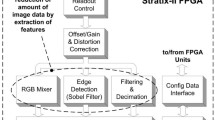Abstract
Advanced CMOS technologies provide continuously more dense and complex integrated circuits, increasing the possibility to utilize Field Programmable Gate Arrays (FPGAs) as a competitor of Mask Programmable Gate Arrays (MPGAs) and as a prototyping device. In this paper, we will overview different FPGA technologies, design systems, application areas, and future trends. The emphasis is on looking these issues from the designer and application point of view instead of technology. The denotion FPGA is used to cover both the FPGAs and complex Programmable Logic Devices (PLDs).
Preview
Unable to display preview. Download preview PDF.
Similar content being viewed by others
References
The Programmable Logic IC Market-Application, Technology and Market Trends. Electronic Trend Publications, Saratoga, CA, USA, 1992.
C. Carruthers and T. Kean. Bipolar cal chip doubles speed of fpgas. In W. Moore and W. Luk, editors, FPGAs, pages 46–53. Abindon EE&CS Books, Abingdon, England, 1991.
Mentor Graphics Corp. FPGA Optimization with AutoLogic FPGA. San Jose, CA, 1991. Vendor Datasheet.
S. Fox and P. Gordon. The ASIC and Programmable IC Strategy Report. Electronic Trend Publications, Saratoga, CA, USA, 1991.
DM Data Inc. Pricing of ASIC Parts-1991. Scottsdale, Arizona, USA, 1991.
J. Isoaho. DSP ASIC Development Based on Prototyping and Bit-Modelling. Licentiate Thesis, Tampere University of Technology, Tampere, Finland, May 1992.
J. Isoaho, J. Pasanen, A. Nummela, and H. Tenhunen. DSP ASIC evaluation with fast prototyping. In Proc. EURO-ASIC92, pages 102–106, Paris, France, June 1992.
J. Isoaho, J. Pasanen, O. Vainio, and H. Tenhunen. DSP system integration and prototyping with FPGAs. Journal of VLSI Signal Processing. To be published 1993.
S. H. Kelem and J. P. Seidel. Context-based ASIC synthesis. In Proc. EUROASIC92, pages 226–231, Paris, France, June 1992.
L. Maliniak. Synthesis tools move into the mainstream. Electronic Design, pages 51–64, Aug. 1991.
L. Maliniak. System simulation still holds promise. Electronic Design, pages 53–61, Feb. 1992.
W. J. McClean. ASIC OUTLOOK 1992 An Application Specific IC Report and Directory. Integrated Circuit Engineering Corporation, Scottsdale, Arizona, USA, 1991.
W. J. McClean. STATUS 1992 A Report On The Integrated Circuit Industry. Integrated Circuit Engineering Corporation, Scottsdale, Arizona, USA, 1991.
W. O. McDermith. A bottom-up approach to FPGA partitioning. In Proc. IEEE 1992 Custom Integrated Circuits Conference, pages 5.4.1.–5.4.4., Boston, USA, May 1992.
J. Nousiainen, J. Isoaho, and O. Vainio. Fast Implementation of Stack Filters with VHDL-Based Synthesis and FPGAs. In Proc. IEEE Winter Workshop on Nonlinear Digital Signal Processing, pages 5.2-4.1–5.2-4.6, Tampere, Finland, Jan. 1993
J. Nousiainen, A. Nummela, J. Nurmi, and H. Tenhunen. Strategies for Development and Modelling of VHDL Based Macrocell Library. In Proc. The European Conference on Design Automation with The European Event in ASIC Design, pages 478–482, Paris, France, Feb. 1993.
A. Nummela, J. Nurmi, J. Isoaho, and H. Tenhunen. Strategies for implementation independent DSP system development using HDL based design automation. In Proc.ASIC'92, Rochester, USA, Sept. 1992.
B. Prince. Semiconductor Memories — A Handbook of Design, Manufacture, and Application (Second Edition). West Sussex, England, 1991.
J. Rose, K. El-Ayat, C. McCarthy, and S. Trimberger. Field-programmable gate arrays. In Design Automation Conference Tutorial, June 1991.
G. Saucier, E. Read, and J. Trilhe, editors. Fast-prototyping of VLSI. Elsevier Science Publishers B.V., Amsterdam, Netherlands, 1987.
M.J.S. Smith. ASIC Technologies. In Proc. Fifth Annual IEEE International ASIC Conference and Exhibit, Rochester, USA, Sept. 1992.
B. Tuck. Designers search for the secret to ease asic migration. Computer Design, pages 78–117, Dec. 1991.
R. R. Tummala and E. J. Rymaszewski. Microelectronics Packaging Handbook. Van Nostrand Reinhold, New York, USA, 1989.
Author information
Authors and Affiliations
Editor information
Rights and permissions
Copyright information
© 1993 Springer-Verlag Berlin Heidelberg
About this paper
Cite this paper
Isoaho, J., Nummela, A., Tenhunen, H. (1993). Technologies and utilization of Field Programmable Gate Arrays. In: Grünbacher, H., Hartenstein, R.W. (eds) Field-Programmable Gate Arrays: Architecture and Tools for Rapid Prototyping. FPL 1992. Lecture Notes in Computer Science, vol 705. Springer, Berlin, Heidelberg. https://doi.org/10.1007/3-540-57091-8_25
Download citation
DOI: https://doi.org/10.1007/3-540-57091-8_25
Published:
Publisher Name: Springer, Berlin, Heidelberg
Print ISBN: 978-3-540-57091-2
Online ISBN: 978-3-540-47902-4
eBook Packages: Springer Book Archive




